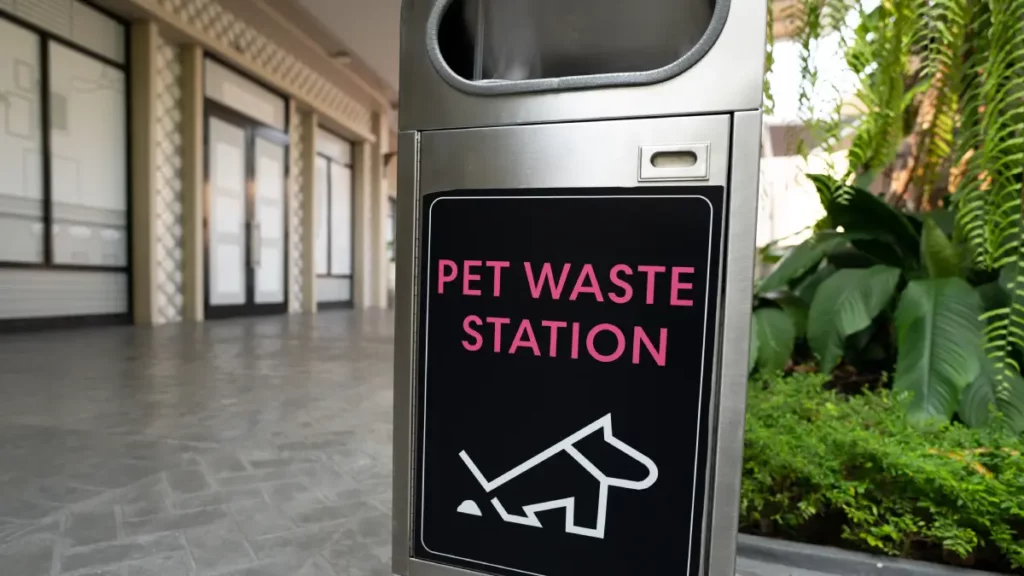Last month, the City of Riverside discovered that three empty dog waste dispensers at their most popular park cost them $4,200 in unexpected expenses. They’re not alone.
As a municipal budget manager or parks director, you track major expenses carefully: labor, equipment, utilities etc. But empty dog waste dispensers? That seems like a minor inconvenience, not a budget line item. Yet cities across the country are discovering that unstocked dispensers create a cascade of hidden costs that can add thousands to annual park maintenance budgets.
The reality is stark: An empty dispenser doesn’t just frustrate residents, it actively drains your municipal budget in ways most cities never calculate.
The True Cost Breakdown: What Empty Dispensers Really Cost Your City
Direct Labor Costs: $1,200-3,600 Per Dispenser Annually
Complaint Response: Each resident complaint about empty dispensers triggers staff response. Municipal data shows:
- Average complaint response time: 45 minutes (includes travel, restocking, documentation)
- Typical maintenance staff hourly cost: $28-42/hour (including benefits)
- Average complaints per empty dispenser: 3-8 per month
Emergency Restocking Visits: Unlike scheduled maintenance routes, empty dispensers require special trips:
- Dedicated restocking visit cost: $35-55 per trip
- Additional vehicle wear and fuel costs
- Disruption to planned maintenance schedules
Real City Example: Sacramento Parks Department calculated that five chronically empty dispensers required 127 unscheduled staff hours annually, that’s equivalent to $4,318 in labor costs that weren’t budgeted.
Cleanup and Sanitation Costs: $800-2,400 Per Location
When dispensers are empty, dog waste doesn’t disappear, it gets left behind, creating expensive cleanup scenarios:
Immediate Cleanup Requirements:
- Biohazard waste removal: $125-200 per incident
- Specialized cleaning equipment and protective gear
- Potential overtime costs for weekend cleanup crews
Secondary Contamination Issues:
- Groundwater testing if waste accumulates near water sources: $300-500 per test
- Specialized sanitization of high-traffic areas: $150-300 per treatment
- Replacement of contaminated mulch or ground cover: $200-600 per area
Case Study: A mid-sized California city spent $8,900 last year on cleanup directly attributable to areas with consistently empty dispensers. These are expenses that could have been prevented with reliable stocking systems.
Administrative and Compliance Costs: $600-1,800 Annually
Empty dispensers don’t just create operational problems, they also generate paperwork:
Documentation Requirements:
- Incident reporting for health department compliance
- Resident complaint processing and follow-up
- Work order generation and tracking for emergency restocking
Compliance Management:
- Health department inspections triggered by complaints: $200-400 per inspection
- Potential fines for unsanitary park conditions: $500-2,000 per violation
- Legal documentation for liability protection
Community Relations Impact: $1,000-5,000 in Opportunity Costs
While harder to quantify, empty dispensers damage community relationships in costly ways:
Reputation Management:
- Staff time addressing city council complaints: 2-4 hours per council meeting
- Social media monitoring and response
- Community meeting time dedicated to waste management issues
Lost Community Support:
- Reduced support for parks improvement bonds
- Negative impact on community satisfaction surveys
- Increased scrutiny on parks department budget requests

The Compound Effect: How Empty Dispensers Multiply Costs
The Domino Effect Analysis
Week 1: Dispenser runs empty
- Cost: $0 (just inconvenience)
Week 2: First complaints arrive
- Staff response time: 1.5 hours ($63 labor cost)
- Emergency restocking: $45
Week 3: Waste accumulation begins
- Additional complaints: 2 hours staff time ($84)
- Initial cleanup required: $150
Week 4: Health concerns develop
- Specialized cleanup: $300
- Incident documentation: 1 hour ($42)
- Additional restocking due to increased usage: $65
Total Month Cost: $749 for one empty dispenser
Multiply that by 10-15 dispensers across your park system, and you’re looking at $7,490 – $11,235 in monthly hidden costs.
Real Municipal Data: Cities That Measured the Impact
Case Study 1: Desert City, Nevada (Population 85,000)
The Problem: 12 dispensers frequently empty due to unreliable supplier Annual Hidden Costs Identified:
- Labor: $14,200
- Cleanup: $8,900
- Administrative: $2,100
- Total: $25,200
The Solution: Switched to automated delivery system Annual Savings: $22,800 (89% cost reduction)
Case Study 2: Coastal City, California (Population 45,000)
The Problem: Manual restocking system couldn’t keep up with summer usage Peak Season Cost Impact:
- Emergency restocking trips: 47 trips at $52 each = $2,444
- Overtime cleanup crews: $6,800
- Health department compliance response: $1,200
- Total Additional Summer Costs: $10,444
The Solution: Implemented usage-based automatic delivery Result: Zero emergency trips, 92% reduction in cleanup costs
The Prevention Math: Investment vs. Hidden Costs
Traditional Reactive Approach Annual Costs:
- Dog waste bags: $2,400
- Emergency restocking: $3,600
- Cleanup responses: $4,200
- Administrative overhead: $1,800
- Total: $12,000
Proactive Automated System Annual Costs:
- Dog waste bags (subscription): $2,600
- Delivery service: $480
- System monitoring: $240
- Total: $3,320
Net Annual Savings: $8,680 per 10-dispenser system

Budget Impact Calculator: Your City’s Hidden Costs
Most municipal managers have never calculated the true cost of empty dispensers. Use these questions to estimate your hidden costs:
Labor Cost Assessment:
- How many complaint calls about empty dispensers per month? ___
- Average staff response time per complaint? ___ hours
- Fully-loaded staff hourly rate? $___
Cleanup Cost Assessment:
- Emergency cleanup incidents per year? ___
- Average cleanup cost per incident? $___
- Specialized waste removal requirements? $___
Administrative Cost Assessment:
- Monthly administrative hours for waste management issues? ___
- Compliance documentation requirements? ___ hours annually
[Interactive Municipal Budget Impact Calculator]
The Strategic Solution: Preventing Hidden Costs
Automated Inventory Management
Key Features:
- Usage-based delivery scheduling
- Automatic restocking before dispensers empty
- Real-time inventory monitoring
Budget Impact: Eliminates 85-95% of emergency response costs
Transparent Cost Structure
What This Means:
- No surprise shipping charges
- Predictable monthly expenses
- NET 30 terms aligned with municipal payment cycles
Budget Impact: Enables accurate budget forecasting and eliminates cost overruns
Quality Products That Perform
Why This Matters:
- Durable bags reduce double-usage
- Reliable packaging prevents waste
- Consistent supply prevents stockouts
Budget Impact: Reduces total cost of ownership by 20-30%
Implementation Framework for Municipal Budget Managers
Phase 1: Cost Assessment (Week 1)
- Audit current hidden costs using our calculator
- Document current supplier performance gaps
- Calculate true cost per bag (including all hidden expenses)
Phase 2: Solution Design (Week 2)
- Map dispenser locations and usage patterns
- Design automated delivery schedule
- Establish performance metrics and monitoring
Phase 3: Implementation (Weeks 3-4)
- Transition to proactive supply system
- Train staff on new procedures
- Establish monitoring and reporting systems
Phase 4: Optimization (Ongoing)
- Monitor cost savings
- Adjust delivery schedules based on usage data
- Document budget impact for annual planning
ROI Analysis: The Numbers Don’t Lie
Typical Municipal System (15 dispensers):
- Current hidden costs: $18,000-28,000 annually
- Optimized system cost: $4,500-6,000 annually
- Net annual savings: $13,500-22,000
- ROI in first year: 300-450%
Payback period: 2-3 months
Take Action: Stop the Budget Drain Today
Empty dog waste dispensers are silently draining your municipal budget. Every day you wait to address this issue costs your city money that could be invested in community improvements, new equipment, or additional services.
Immediate Next Steps:
- Calculate Your Hidden Costs: Use our Municipal Budget Impact Calculator to quantify what empty dispensers are really costing your city
- Request a Custom Analysis: Get a detailed assessment of your current system’s inefficiencies and potential savings
- Implement Prevention Strategy: Move from reactive to proactive waste management with automated delivery systems
Free Municipal Resources:
- Hidden Cost Calculator
- ROI Analysis Worksheet
- Implementation Timeline Template
- Budget Planning Guide
[Download Free Municipal Analysis Kit] [Request Custom Budget Assessment]
Make the change by creating a strategy
Your residents deserve clean parks, your staff deserves efficient systems, and your budget deserves protection from unnecessary hidden costs. The solution isn’t complicated, it’s strategic.
Ready to eliminate hidden costs and optimize your municipal dog waste management budget?
[Get Municipal Quote] [Schedule Budget Consultation]



